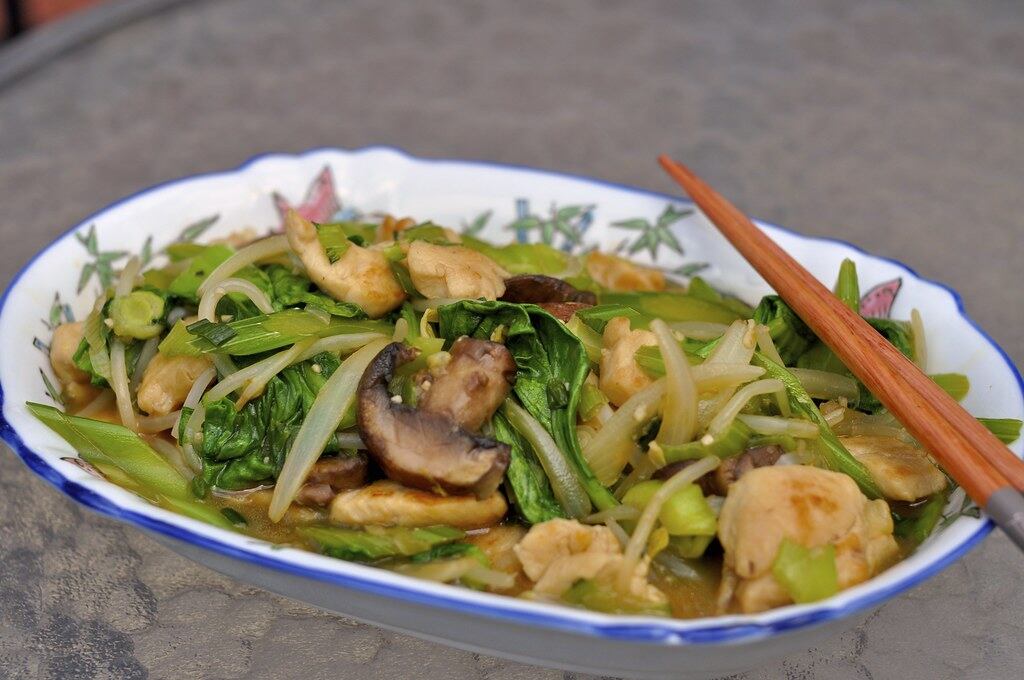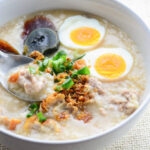Chop Suey is a popular Chinese-American dish that has become a staple in many Chinese restaurants around the world. The term “chop suey” is derived from the Cantonese words meaning “assorted pieces” or “odds and ends.”
Chop Suey is typically made with a combination of stir-fried vegetables, such as bean sprouts, cabbage, carrots, mushrooms, and onions, along with your choice of meat or seafood. The vegetables and meat are cooked together in a flavorful sauce, which can vary depending on the recipe and the chef’s preference. Common sauce ingredients include soy sauce, oyster sauce, garlic, ginger, and various spices.
The origins of Chop Suey are a bit unclear, but it is believed to have been created by Chinese immigrants in the United States during the late 19th century. It was originally developed as a way to use up leftover ingredients and adapt Chinese cooking to suit American tastes. Over time, Chop Suey gained popularity and became a mainstay in Chinese-American cuisine.
Chop Suey is known for its versatility, as it can be customized to suit different dietary preferences and tastes. Vegetarian and vegan versions are common, where tofu or other plant-based proteins are used instead of meat. It is often served over steamed rice or noodles, making it a satisfying and filling meal.
While Chop Suey may not be an authentic Chinese dish, it has become an integral part of Chinese-American culinary culture. Its popularity has spread to other parts of the world, and it continues to be enjoyed by many people as a delicious and comforting meal.
| Ingredients: | |
| 1 | 1 pound (450 grams) of boneless chicken, beef, pork, shrimp, or tofu (cut into thin strips) |
| 2 | 2 tablespoons vegetable oil |
| 3 | 1 onion (sliced) |
| 4 | 2 garlic cloves (minced) |
| 5 | 1 cup bean sprouts |
| 6 | 1 cup sliced cabbage |
| 7 | 1 carrot (julienned) |
| 8 | 1 bell pepper (sliced) |
| 9 | 1 cup sliced mushrooms |
| 10 | 2 tablespoons soy sauce |
| 11 | 2 tablespoons oyster sauce |
| 12 | 1 teaspoon cornstarch (optional, for thickening) |
| 13 | Salt and pepper to taste |
| 14 | Cooked rice or noodles for serving |
Step-by-step cooking instructions of Chop Suey:
Step-1 Heat the vegetable oil in a large skillet or wok over medium-high heat.
Step-2 Strips of meat or tofu should be added to the skillet and cooked through until browned. Remove from the skillet and put it to the side.
Step-3 In the same skillet, add the sliced onion and minced garlic. Sauté until fragrant and the onion become translucent.
Step-4 Add the bean sprouts, cabbage, carrot, bell pepper, and mushrooms to the skillet. Stir-fry for a few minutes until the vegetables are tender-crisp.
Step-5 Mix the soy sauce and oyster sauce in a small bowl. After pouring the sauce over the vegetables, toss them in it.
Step-6 If you prefer a thicker sauce, mix the cornstarch with a little water to make a slurry. Add the slurry to the skillet and stir until the sauce thickens slightly.
Step-7 Return the cooked meat or tofu to the skillet and toss with the vegetables and sauce. Cook for an additional minute or two to heat everything through.
Step-8 Season with salt and pepper to taste.
Step-9 Serve the Chop Suey over steamed rice or noodles.
Nutritional value of Chop Suey:
The nutritional value of Chop Suey can vary depending on the specific ingredients and cooking methods used. Here’s a general breakdown of the nutritional components you can expect in a typical serving of Chop Suey:
| 1 | Calories: The calorie content of Chop Suey can vary based on the ingredients and portion size. On average, a serving of Chop Suey (about 1 cup) can range from 150 to 300 calories. |
| 2 | Protein: The protein content will depend on the choice of protein used, such as chicken, beef, pork, shrimp, or tofu. In general, a serving of Chop Suey can provide around 10 to 20 grams of protein. |
| 3 | Carbohydrates: The carbohydrate content mainly comes from the vegetables and any rice or noodles served with the dish. A serving of Chop Suey can contain approximately 15 to 30 grams of carbohydrates. |
| 4 | Fat: The fat content will depend on the cooking oil used and the choice of protein. The addition of sauce ingredients like oyster sauce can also contribute to the fat content. On average, a serving of Chop Suey can contain around 5 to 15 grams of fat. |
| 5 | Fiber: The fiber content will primarily come from the vegetables used in the dish. A serving of Chop Suey can provide approximately 2 to 4 grams of fiber. |
| 6 | Vitamins and Minerals: Chop Suey made with a variety of vegetables can be a good source of vitamins and minerals. It may provide vitamins A, C, and K, as well as minerals like potassium and magnesium. The specific amounts will depend on the vegetables used and their quantities. |
Background History of Chop Suey:
The background history of Chop Suey is quite intriguing, as it has roots in the Chinese-American immigrant experience during the late 19th century. While there are different accounts and theories about its origin, the following provides a general overview of the history.
Chop Suey is believed to have originated in the United States, particularly in California, during the 1880s. At that time, Chinese immigrants faced numerous challenges and discrimination while seeking opportunities in the country. They encountered cultural differences and had to adapt their traditional Chinese cuisine to suit the tastes and ingredients available in their new surroundings.
According to one popular theory, Chop Suey was created in response to the demands of non-Chinese customers who wanted to experience Chinese cuisine but were not accustomed to the traditional flavors and ingredients. To cater to these preferences, Chinese chefs started experimenting with adapting their recipes, using locally available ingredients and modifying cooking techniques.
The term “Chop Suey” itself is derived from the Cantonese words “tsaap sui” (杂碎), which roughly translates to “assorted pieces” or “odds and ends.” This name accurately reflects the nature of the dish, which typically combines a variety of ingredients, such as meats, vegetables, and sauces, into one flavorful stir-fry.
While the exact inventor of Chop Suey remains unknown, it is clear that Chinese immigrants played a significant role in its creation and popularization. It gained fame as a flexible and adaptable dish that could incorporate a range of ingredients, making it appealing to both Chinese and non-Chinese diners.
Chop Suey quickly became a favorite in Chinese-American communities and gradually spread across the United States. Its popularity continued to grow, and by the early 20th century, Chop Suey had become a prominent feature on Chinese restaurant menus throughout the country.
Over time, variations of Chop Suey emerged, reflecting regional and individual preferences. Different vegetables, meats, and sauces were incorporated, resulting in a diverse range of Chop Suey recipes.
Today, Chop Suey remains an iconic and beloved dish in Chinese-American cuisine. While it may not be considered an authentic Chinese dish, its historical significance and cultural impact make it an important part of Chinese culinary heritage in the United States.
| Advantages of Chop Suey: | |
| 1 | Versatility: Chop Suey is a versatile dish that can be customized to suit various dietary preferences and restrictions. It can easily accommodate different types of proteins, including chicken, beef, pork, shrimp, or tofu, and can be adapted to include a wide range of vegetables. |
| 2 | Balanced Meal: Chop Suey typically includes a combination of vegetables, protein, and sauce, making it a well-rounded and balanced meal. It provides essential nutrients from vegetables and protein sources, offering a good mix of vitamins, minerals, and fiber. |
| 3 | Flavorful and Enjoyable: Chop Suey is known for its delicious flavors, thanks to the combination of stir-fried ingredients and savory sauces. The mix of vegetables and protein cooked in the sauce creates a satisfying and tasty meal. |
| 4 | Quick and Easy to Prepare: Chop Suey is a relatively quick and simple dish to prepare. With some chopping and stir-frying, it can be cooked within a short amount of time, making it suitable for busy individuals or families. |
| 5 | Customizable: Chop Suey allows for creativity and personalization in the kitchen. You can experiment with different vegetables, proteins, and sauces to suit your taste preferences or use up ingredients you have on hand. |
| Disadvantages of Chop Suey: | |
| 1 | High Sodium Content: Depending on the choice of sauces used, Chop Suey can have a high sodium content. Soy sauce and oyster sauce, commonly used in Chop Suey recipes, can be high in sodium. This may be a concern for individuals on a low-sodium diet or those with certain health conditions. |
| 2 | Variable Nutritional Content: The nutritional value of Chop Suey can vary depending on the specific ingredients used and the cooking methods employed. It’s important to be mindful of the types and amounts of ingredients added, as well as the portion sizes, to ensure a well-balanced and nutritious meal. |
| 3 | Potential for Unhealthy Ingredients: Some Chop Suey recipes may include ingredients or cooking techniques that are less healthy, such as using excessive amounts of oil or deep-frying the proteins. It’s important to choose healthier cooking methods and ingredients when preparing Chop Suey. |
| 4 | Allergenic Ingredients: Chop Suey often contains common allergenic ingredients like soy, wheat, and shellfish (if using shrimp). Individuals with food allergies or sensitivities need to be cautious and ensure that the dish is prepared without any allergens that may affect their health. |
Alternative meal of Chop Suey:
If you’re looking for alternative meals similar to Chop Suey, here are a few options:
| 1 | Lo Mein: Lo Mein is a Chinese stir-fried noodle dish that typically includes a combination of noodles, vegetables, and protein. It shares similarities with Chop Suey but places a stronger emphasis on the noodles as the main ingredient. Lo Mein can be customized with your choice of protein and vegetables, and it is commonly seasoned with soy sauce or other flavorful sauces. |
| 2 | Buddha’s Delight: Also known as Luo Han Zhai or Jai, Buddha’s Delight is a vegetarian stir-fry dish originating from Buddhist cuisine. It features an assortment of vegetables, mushrooms, tofu, and sometimes bean curd sheets, cooked in a light sauce. Buddha’s Delight is often enjoyed during vegetarian festivals or by those following a vegetarian or vegan lifestyle. |
| 3 | Stir-Fried Mixed Vegetables: This dish focuses solely on a variety of vegetables, stir-fried to retain their crispness and natural flavors. It typically includes a combination of vegetables like broccoli, carrots, bell peppers, snow peas, mushrooms, and baby corn. The vegetables are quickly cooked in a hot wok with a light sauce or seasoning to enhance their taste. |
| 4 | Kung Pao Chicken: Kung Pao Chicken is a popular Chinese stir-fry dish that combines diced chicken, peanuts, and vegetables in a spicy and savory sauce. It offers a flavorful balance of ingredients and is known for its signature combination of heat from dried red chili peppers and the numbing sensation of Sichuan peppercorns. |
| 5 | Cashew Chicken: Cashew Chicken is a delicious stir-fry dish originating from Chinese-American cuisine. It features diced chicken, cashew nuts, and a medley of vegetables, such as bell peppers and onions, in a savory sauce. It offers a delightful combination of textures and flavors, with the nuttiness of the cashews adding a pleasant crunch. |
These alternative meals provide a range of flavors, ingredients, and cooking styles to explore beyond Chop Suey. They offer diverse options to suit various dietary preferences, including vegetarian, vegan, and protein-based choices.
Mostly questions asked about Chop Suey:
Q: What is Chop Suey?
A: Chop Suey is a Chinese-American stir-fry dish that typically consists of a combination of vegetables, meat or tofu, and a savory sauce. It is known for its diverse ingredients and flavors.
Q: Where did Chop Suey originate?
A: Chop Suey originated in the United States, particularly in California, during the late 19th century. It was created by Chinese immigrants who adapted their traditional cuisine to suit American tastes and ingredients.
Q: Is Chop Suey an authentic Chinese dish?
A: Chop Suey is not considered an authentic Chinese dish. It was created by Chinese immigrants in the United States, blending Chinese culinary techniques with locally available ingredients.
Q: What are the typical ingredients in Chop Suey?
A: The typical ingredients in Chop Suey include a combination of vegetables such as bean sprouts, cabbage, carrots, bell peppers, and mushrooms, along with a choice of protein like chicken, beef, pork, shrimp, or tofu. It is seasoned with sauces like soy sauce and oyster sauce.
Q: Can Chop Suey be vegetarian or vegan?
A: Yes, Chop Suey can be made vegetarian or vegan by using tofu or a variety of vegetables as the protein component and ensuring that the sauces used are free of animal products.
Q: How is Chop Suey different from other stir-fry dishes?
A: Chop Suey stands out due to its mixed combination of ingredients, including various proteins and vegetables, cooked together in a sauce. Other stir-fry dishes may focus on specific ingredients like noodles, or primarily feature a single type of protein or vegetable.
Q: What sauces are used in Chop Suey?
A: The sauces commonly used in Chop Suey include soy sauce and oyster sauce, which provide savory and umami flavors. Additional seasonings like garlic, ginger, and cornstarch may also be used to enhance the taste and texture.
Q: What is the best protein to use in Chop Suey?
A: The choice of protein in Chop Suey is a matter of personal preference. Common options include chicken, beef, pork, shrimp, or tofu. Select the protein that you enjoy the most or tailor it to dietary preferences.
Q: What vegetables can be used in Chop Suey?
A: Chop Suey is versatile and can incorporate various vegetables such as bean sprouts, cabbage, carrots, bell peppers, mushrooms, snow peas, or water chestnuts. You can customize the vegetables based on your preference and availability.
Q: How is Chop Suey typically served?
A: Chop Suey is typically served over steamed rice or noodles. The combination of flavors and textures in Chop Suey makes it a satisfying and complete meal when paired with these starches.







